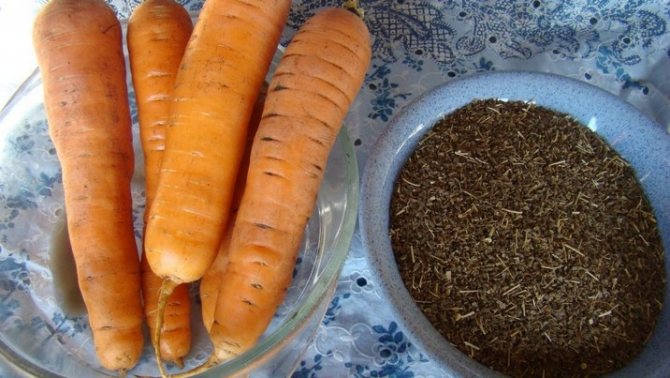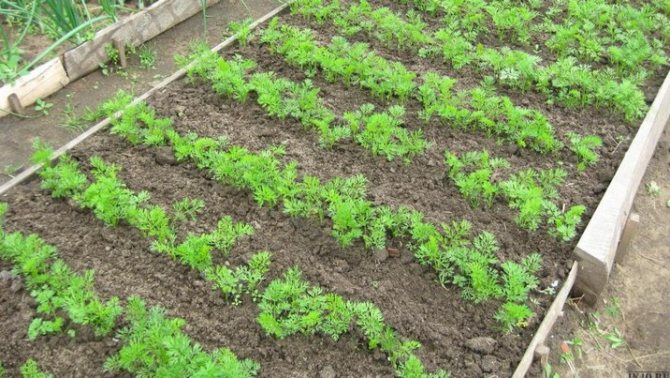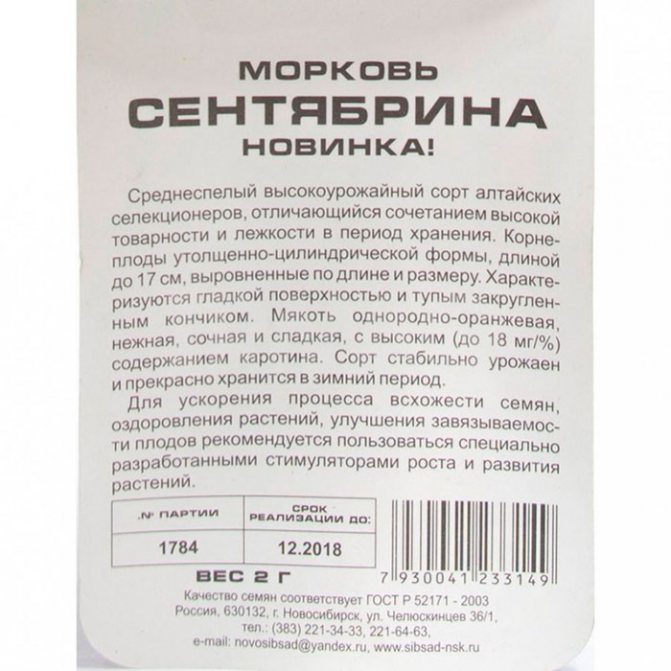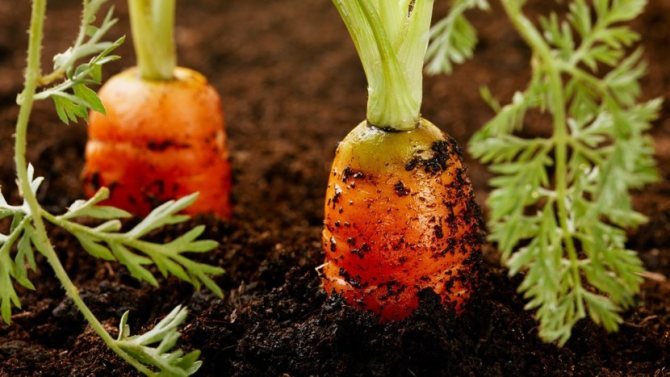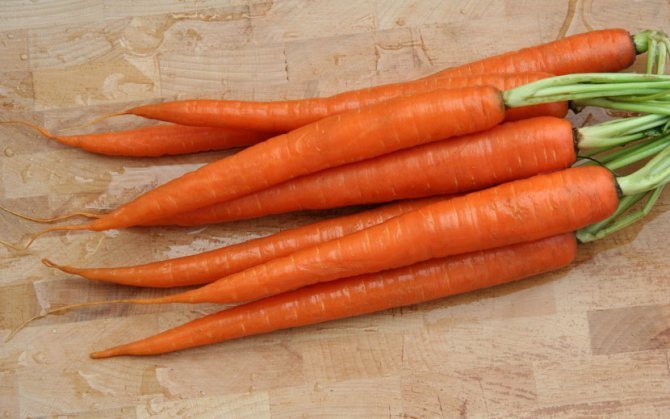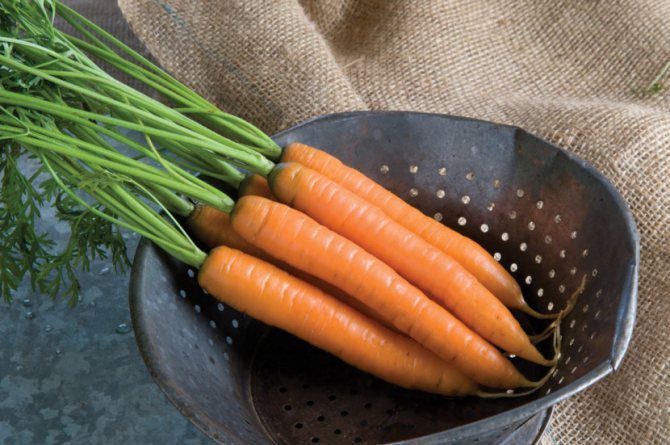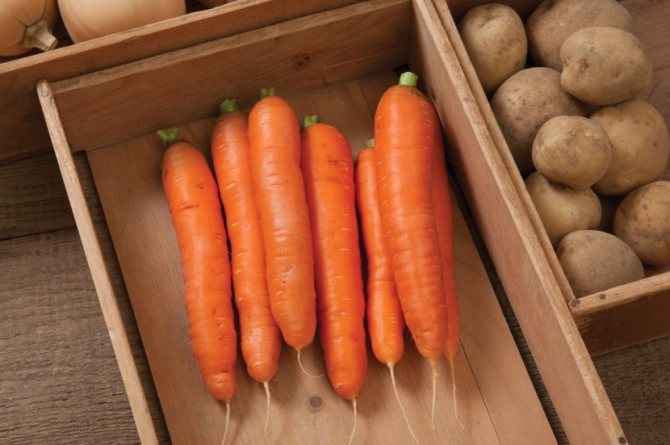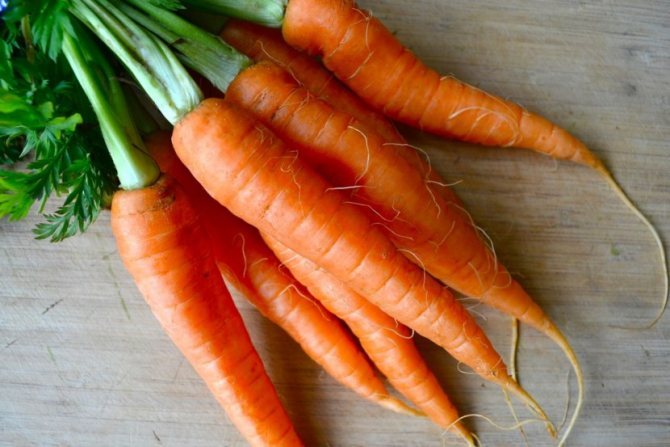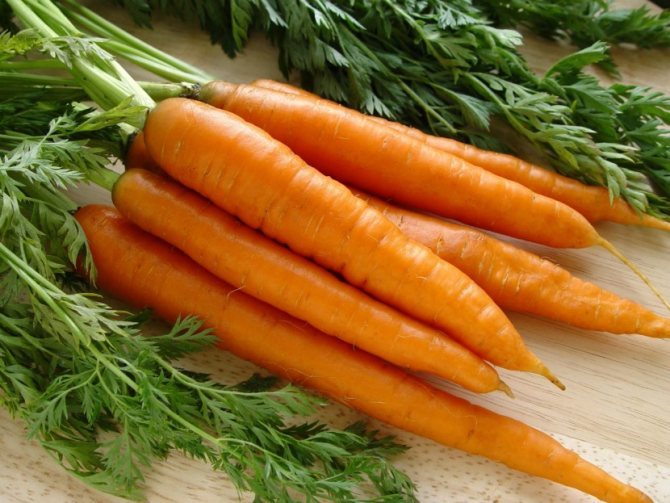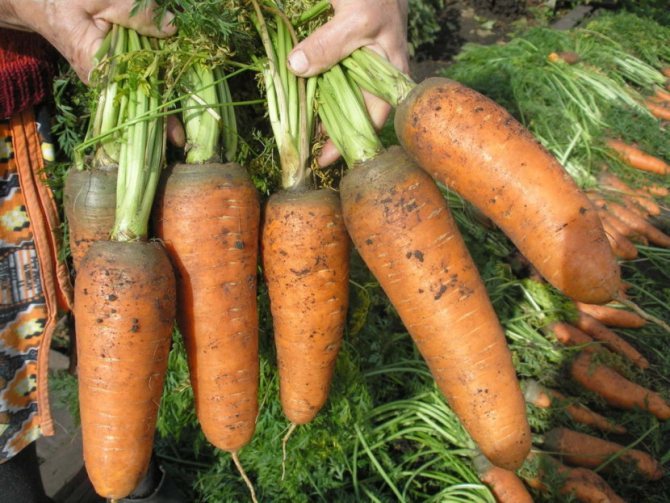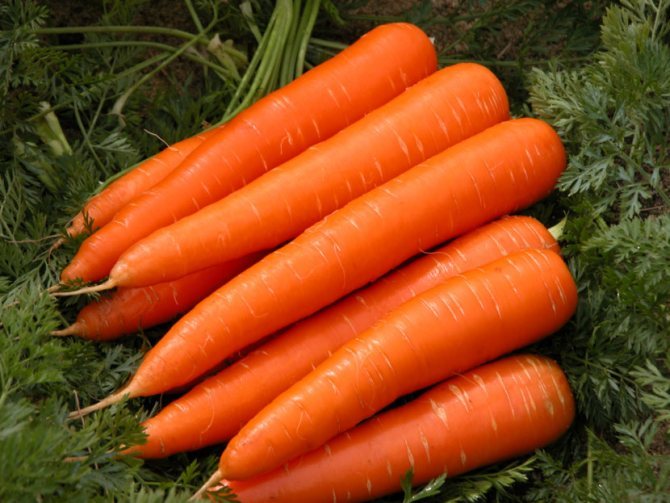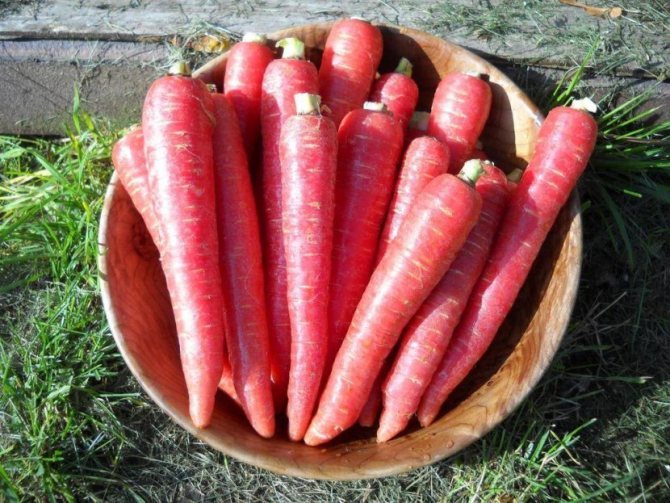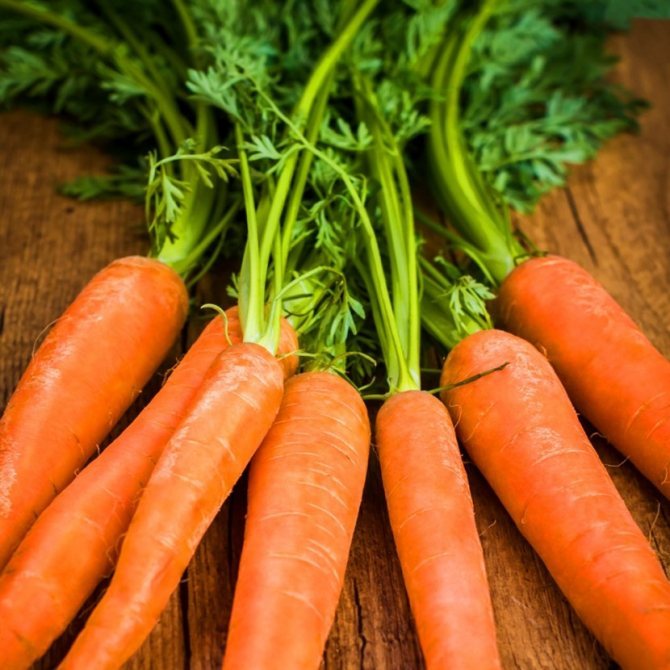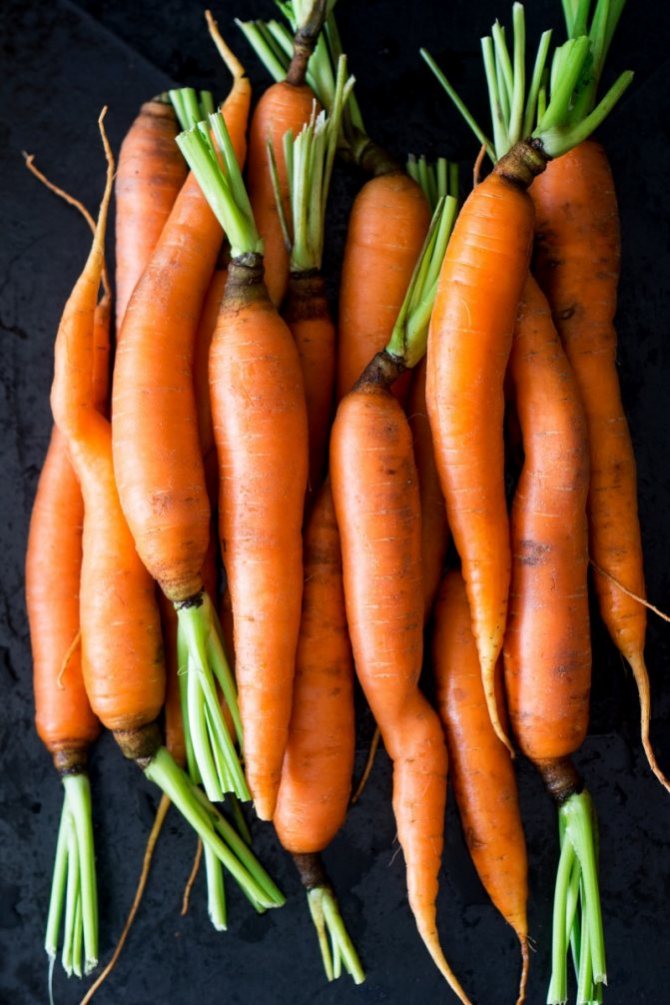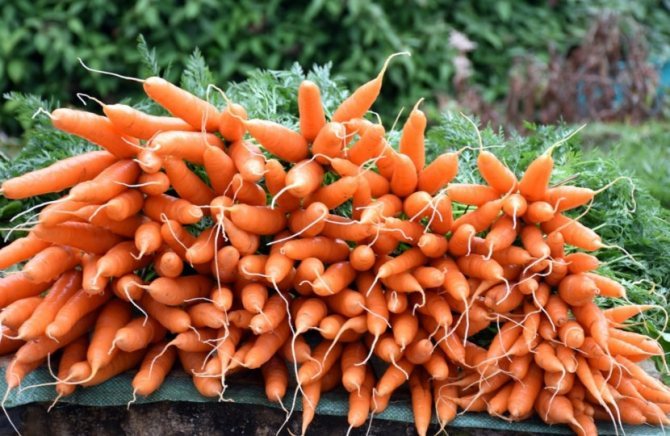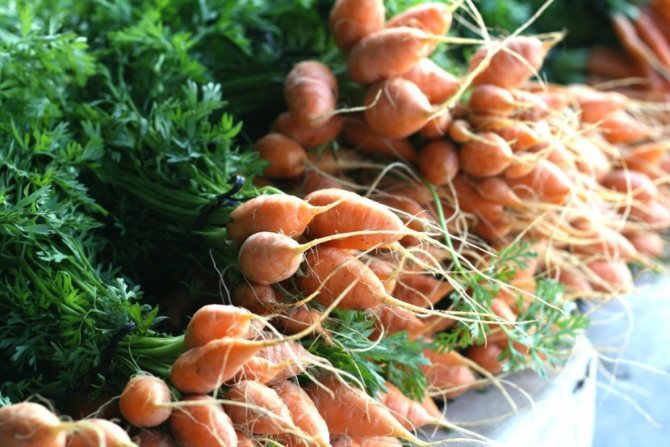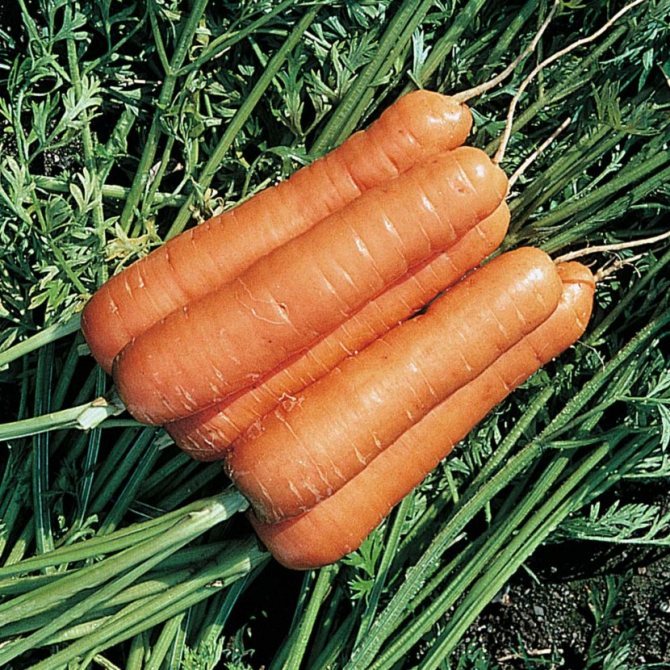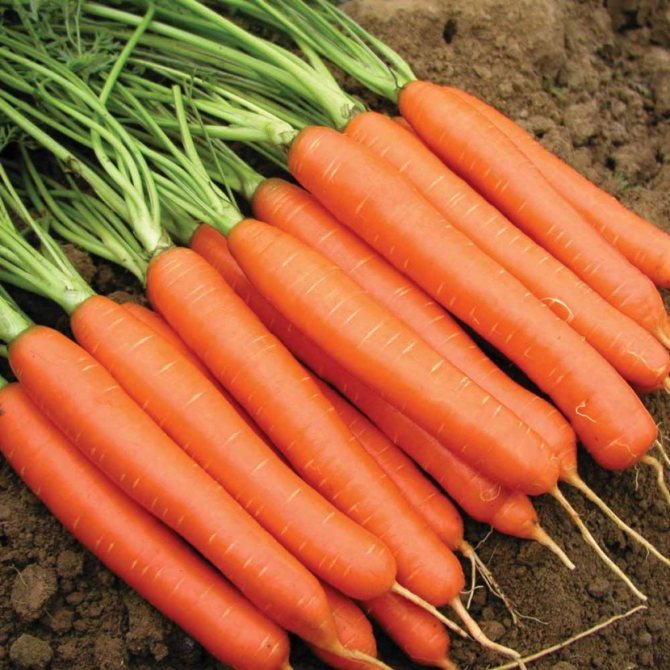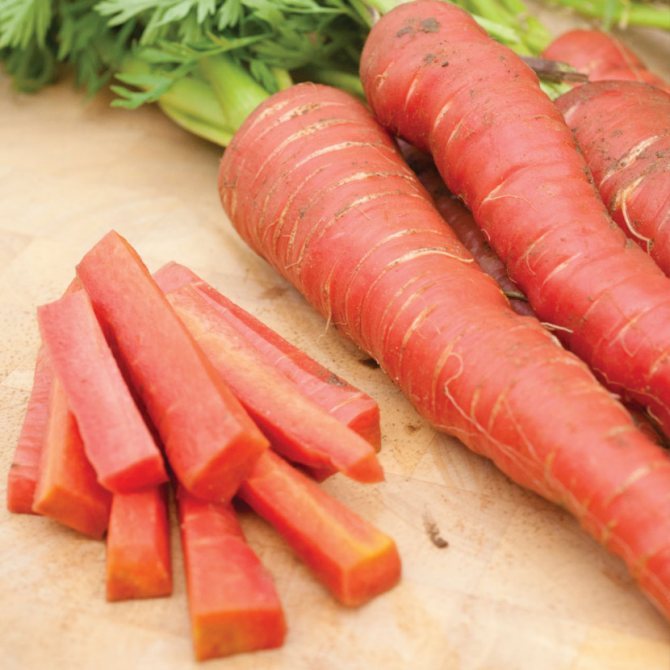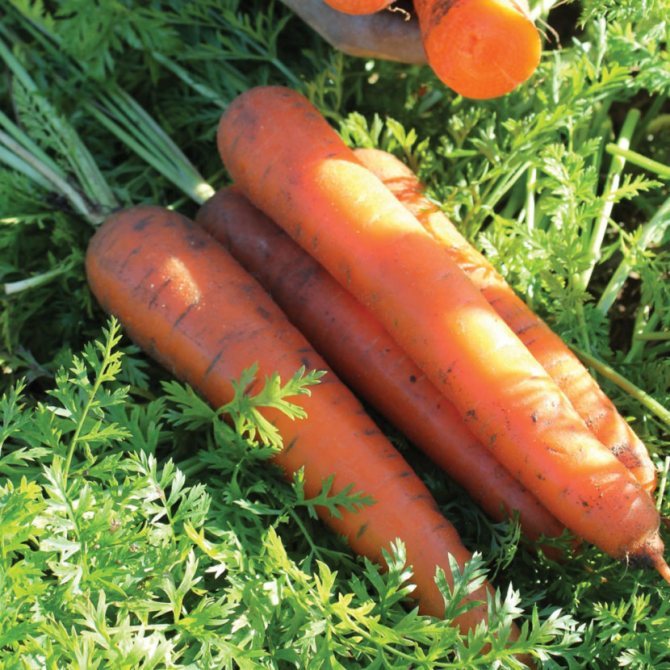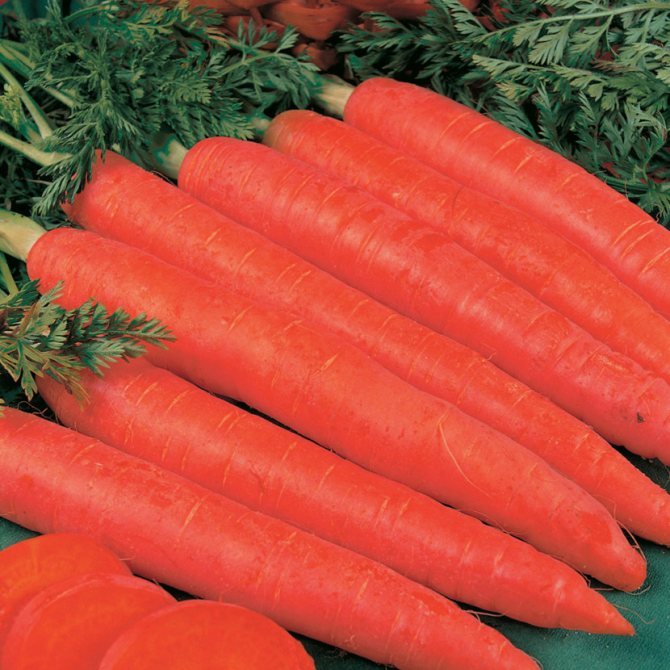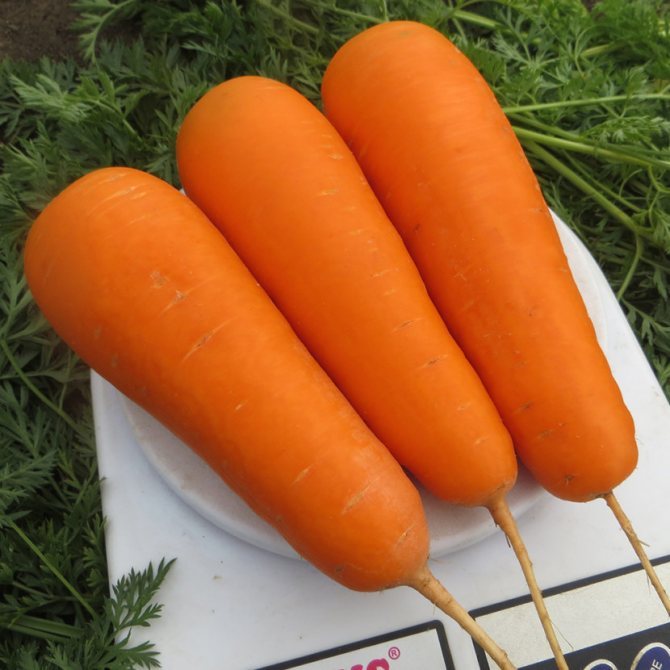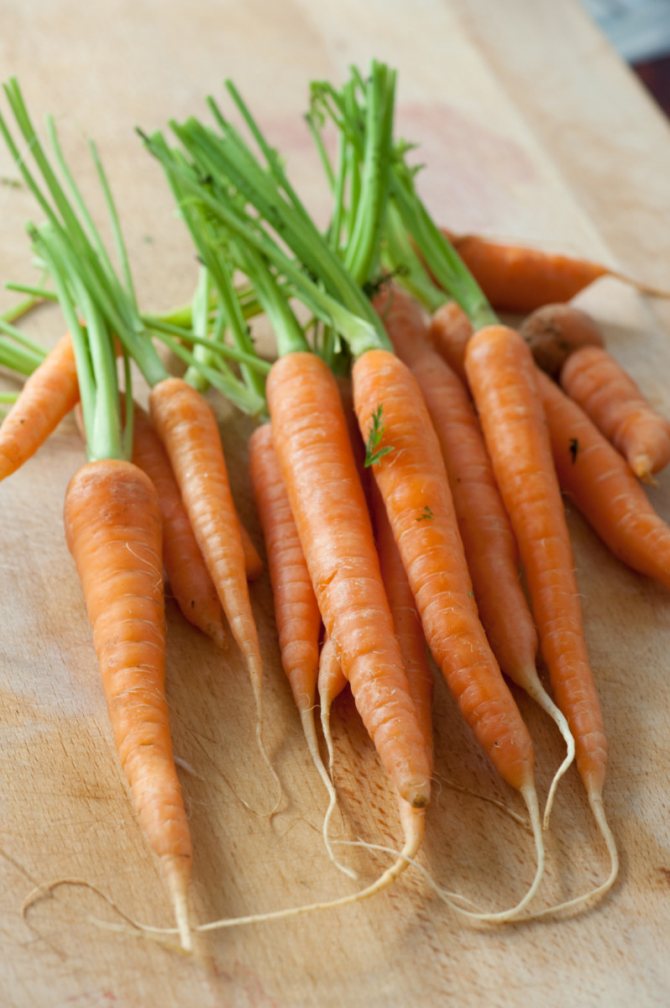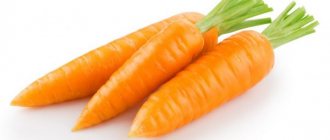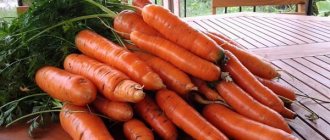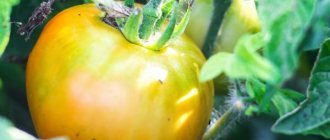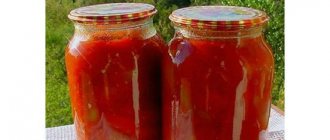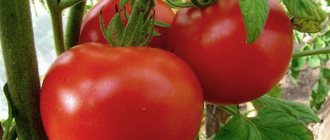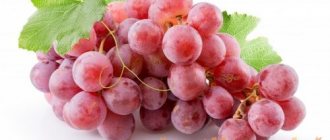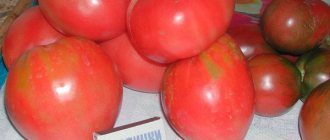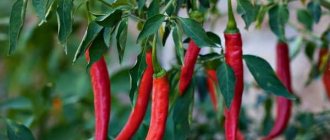The carrot is a biennial plant. Belongs to the Umbrella family and has pinnately dissected leaves.

It is still not known where it first appeared. However, Afghanistan is considered its homeland. It came to the European part only in the XX century. And her orange color was first bred in Holland in the 17th century.
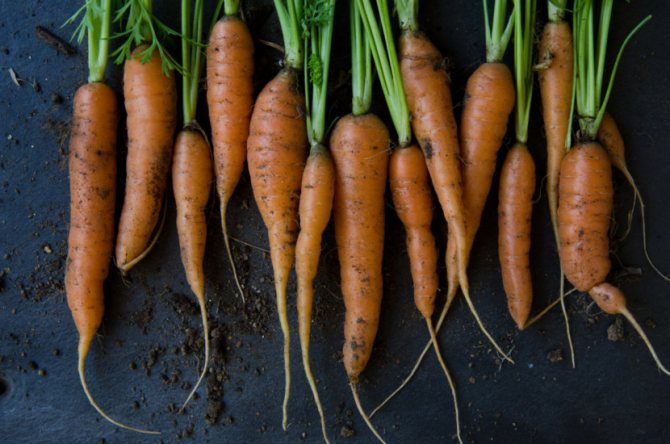

Today, there are more than 60 species of this root crop. In the photo of carrots, you can see how much they have significant differences among themselves, in weight, color, size.
What is the sweetest and most fruitful carrot
Carrots are considered one of the main sources of carotene, which is split into vitamin A in the human liver. Vitamin A is one of the components of many important processes in the human body:
- is a component of rhodopsin, which is responsible for night vision;
- accelerates the healing of superficial skin lesions;
- helps to maintain skin elasticity;
- improves immunity.
All these benefits arise at the cellular level. It makes no sense to smear scratches with carrot juice in the hope of accelerated healing.
Parents usually know about the benefits of vitamin A and carrots as a source of carotene, and try to feed the child with carrots, looking for sweet varieties, since not all children are enthusiastic about parenting ideas.
Especially for children, not only sweet, but also very juicy crunchy carrots were bred. After all, just chewing sweet is not as interesting as eating sweet and crunchy.
Planting and leaving
On black soil, carrots grow well, but soil with admixtures of sand or clay is also quite suitable for it. But when choosing a place, it is better to stay in a sunny area. Before planting, as usual, the earth is dug up and watered. The planting itself is done closer to the second half of spring (although here you need to look at the temperature - the plant is resistant to its low marks). It will be nice to additionally cover the soil where the carrot seeds have just been thrown with a cloth.
The planting process itself is simple: the grooves are made, alternating with empty spaces of 15-20 cm. A change is planted in the grooves, leaving 1-2 cm between them. This tactic will allow you to thin out seedlings less.
For further care you will need:
- thin out the plants so that between the carrots there are 6-8 cm "for growth";
- weed out weeds;
- loosen two or three times between the rows;
- in addition, you will need to water the carrots and feed them with fertilizers.
Several important points when landing:
- The place chosen for the beds must be clean of weeds that can "kill" immature carrots (especially wheatgrass). It is great if onions, cucumbers, cabbage were grown in this place last year, since the residues of organic fertilizer, which is usually used when caring for these plants, will be enough for Nandrin.
- Although there are few requirements for the soil, its acidity should not exceed 6-7 units.
- To fertilize the beds before sowing, it is better to use exclusively complex mineral fertilizers.
How to sow?
In order for the carrots to grow, it is enough for the soil to warm up by 3-4 degrees. If after sowing a frost suddenly came, you should not be afraid.
The emerging seedlings are able to survive a drop in temperature to -4 C. The high content of essential oils in the seeds and their small size somewhat prolong the germination time.The beds will turn green only two weeks later (sometimes on the 16th day) after sowing.
If you want to have carrots all the time, you need to sow them several times:
- In order to have fresh carrots on the table in spring, they are sown in October (closer to the second half), before the first snowfalls.
- Nandrin planted in spring is removed in August.
- If you want to store your carrots in winter, sow them in June. Then the harvest will ripen by the end of September-beginning of October.
When sowing in autumn, about seven grams of seeds are consumed per 1m2, in spring less seeds are spent - 4-5 grams.
Watering and thinning rules
The first thinning is done when the shoots are three centimeters. As a result, two centimeters should remain between the bushes.
A little later, when the carrot reaches 0.5-1 cm in diameter, it is thinned out again. The correct distance between roots is now 4 to 6 centimeters.
Of course, carrots should not be allowed to overgrow with weeds - this is destructive for her. Loosening is beneficial, helping the roots to receive oxygen.
During the period of fruit juicing, it is not watered too often. Water consumption - 5-6 liters of water per 1m2.
Varieties of "baby" juicy carrots
Baby Sweetness
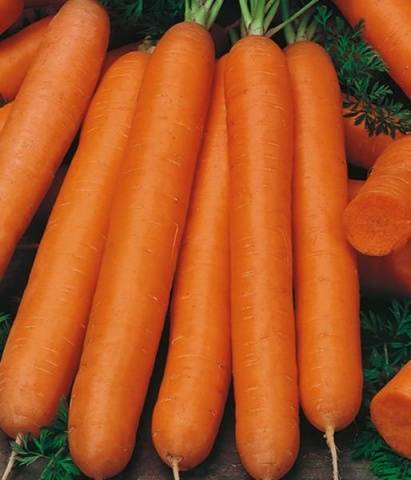

A mid-season carrot variety with elongated cylindrical roots. The root vegetable has a rich orange color. The core is darker than the shell. It is widely used for making fresh varieties and baby purees.
Matures for 110 days. It is sown at the end of April to a depth of 15 mm. The variety can withstand frosts down to -4 ° C. Carrots can be sown before winter. Winter crops are sown after a steady drop in temperature to + 5 ° C. This is usually October - early November. Seeds are planted to a depth of 1 cm and mulching must be carried out.
The dimensions of this variety are: length 10-15 cm, weight 90-130 g.
Children's joy
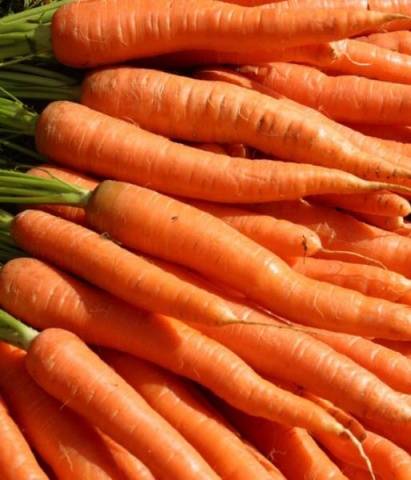

The variety contains 19 mg of carotene per 100 g of dry matter and 8.5% saccharides. Its pleasant taste is enjoyed by both children and adults.
Carrots ripen in 100 days. The fruits are bright orange. The mass of root crops is 120 g with a length of 20 cm. Such a small diameter of carrots is very suitable for those who like to eat carrots right from the garden. Yes, most often they are children.
The variety is sown from the end of April at a soil temperature of + 6 °. In general, carrots for this variety are the same as for others. Thinning the plantings in two steps, finally leaving a distance between the roots of 6 cm.
Watering is carried out evenly, taking into account the characteristics of the region, during the entire growing period. Optimum watering time: evening. Water consumption:
- for young carrots: half a bucket per m²
- for an adult 7 l / m² every 9 days.
Agricultural machinery carrots Nandrin F1
Planting seeds
Carrots are biennial plants. Its cold resistance is relatively high: seeds germinate at a soil temperature of 3-4 degrees, and the emerging seedlings are able to withstand frost down to -4 degrees.
Since carrot seeds are small (about 800 units in each gram), their germination occurs slowly (the first shoots usually appear no earlier than 14 days, massively - on the 16th day). Growth and development in the early days are also slowed down.
You can sow carrot seeds Nandrin F1 throughout spring, in early summer and late autumn - for the winter. Spring sowing is carried out immediately after the snow melts and the spring tillage. The second sowing is carried out in June. With a ripening period of 105 days plus two weeks for the first shoots to appear, the harvest will be ready in October.
In the same period, the autumn sowing of carrots is carried out. The main condition for successful autumn sowing is to carry it out before the soil freezes, preferably even two or three weeks before the first frost, and always with dry seeds.
The seed consumption rate for sowing in the fall is 6–7 grams per square meter of the garden; for spring sowing, 4–5 grams is enough.
Loosen the soil thoroughly and remove all weeds. Sow evenly. The distance between the rows is within 15–20 centimeters. Sow seeds in a row with an interval of 10–20 millimeters in order to avoid overly dense shoots and, accordingly, thinning, which can injure the plants.
Conditions for the growth of carrots
There are several conditions for obtaining a good harvest of Nandrin F1:
- The correct choice of site. The carrot bed must be free of weeds (especially wheatgrass). Plant carrot seeds in areas where previously grown cucumbers, nightshade crops, onions, cabbage, previously fertilized with organic matter.
- The reaction of the soil (pH) is within the range of 7–6, that is, from slightly acidic to neutral.
- Apply only mineral, complex fertilizers before planting seeds. Or fertilize with the following composition: urea - 10-15 grams per square meter, superphosphate - 30-40 grams, potassium chloride - 15-20 grams.
Caring for the Nandrin F1 hybrid consists in carrying out the following operations:
- When the shoots reach 2–3 cm, thin them out, leaving a gap of 1–2 centimeters between the shoots.
- Thin a second time when the root crops reach a diameter of 0.5–1 cm. The distance between plants of Nandrin F1 carrots should be 4–6 cm.
- Weed young plants regularly, manually remove weeds and loosen the row spacing.
- Water the hybrid 2–4 times during the growing season during the period of increased root formation. For every square meter of land, 5–6 liters of water are enough.
Are you fond of gardening?
Pesticides from Farmer Center Wholesale are primarily:
- original products,
- high quality
- and as a result, a high yield!
Herbicides
| Glyfovit Extra | Antisapa | Tivitus | Glyfovite |
Insecticides
| BI-58® | Antikhrusch | Coragen | Presto |
Disinfectants
| Record Quadro | Ultrasil | Matador | Ace Selective |
Fungicides
| Delan | Shavit | Ridomil Gold | Dezaral |
and much more on the site https://enn.imadeself.com/
On dry and hot days, watering starts from 3 l / m², after a couple of days the amount of water is increased to 7 l / m². Pour water gradually so that the soil is saturated with moisture. If you pour a lot of water into dry soil at once, the carrots will crack and become unusable for long-term storage.
Children's F1
A mid-season variety that can be harvested 105 days after sowing. Fruits are long, 18 cm. The same diameter along the entire length. Contains a large amount of carotene, is used in dietary and baby food. Suitable for long-term storage.
Prefers well-lit areas. In the shade, it loses its taste and reduces yield.
Juicy sweet
A mid-season variety with beautiful even root crops up to 20 cm long. Fruit weight is 100 g. The color is bright orange, the core is almost invisible. Planted in April-May, the harvest is harvested in August-September.
For the convenience of consumers, the manufacturer today offers seeds of this variety on tape and in gel pills.
The tape with seeds is placed “on the edge” in grooves 15-20 mm deep. The grooves must first be watered. After the tape is covered with peat or sawdust and periodically watered. When planting carrots on a tape, there is no need to thin out the planting.
New planting method: seeds in gel pills.
The seeds in such dragee do not need watering for the first time (2 weeks) after planting. But they are planted in the same way as ordinary seeds.
Sweet tooth
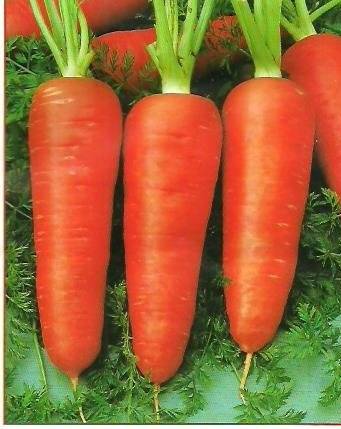

Probably the best carrot variety with one slight drawback: late maturity. It takes 4 months to ripen. Grows best on light loams.
The variety is excellently stored in winter, including in the ground, frost-resistant. You can sow before winter.
Root crops are conical, large, weighing 100 g. They contain an increased amount of saccharides and provitamin A. Recommended for baby food and fresh juices. It can be used for these purposes even in winter.
In stores, alas, such carrots are rare. And most often it tastes bitter due to the abundance of chemicals in it.It is dangerous to feed these carrots even to animals.
Early ripe carrots are very juicy, but almost all of them are unsweetened.
Why can the curve grow?
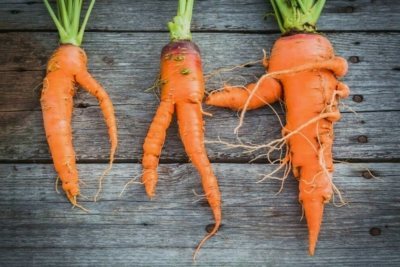

Main reasons:
- stony or clay soil;
- an excess of organic fertilizer;
- drought and lack of watering;
- thickening of seedlings and lack of weeding;
- root damage due to untimely weeding;
- an excess of calcium in the soil due to the introduction of lime;
- excess chlorine;
- damage by pests;
- late harvest.
You can find out more about the causes of defective carrots here.
Juicy carrot varieties "for adults"
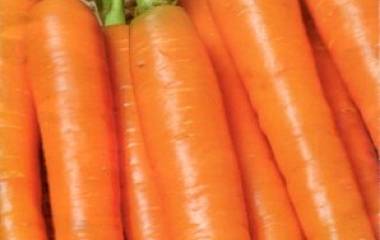

Carrots with a high content of saccharides. The variety is mid-season, it can be laid for long-term storage.
It takes about 100 days to mature. With proper cultivation, it grows up to 20 cm. This variety can be sown from March to June. If you plant the seeds in several steps with a time gap, then you can collect fresh carrots from June to October.
The manufacturer today offers seeds of this variety in a gel dragee. The gel allows the first time not to worry about the lack or excess of moisture, protecting the seed from adverse conditions.
After watering, the gel absorbs some of the water and gradually gives it to the seed. Excess water passes by. Thus, in a drought, the seed is provided with water, and in heavy rains, it is protected from the "swamp".
Agricultural technology for planting seeds in a gel dragee is very simple:
- seeds are sown at a distance of 20 mm from each other and watered;
- sprinkle with earth and spill well again;
- forget about crops for a couple of weeks.
After 2-3 weeks, the crops are cared for according to the standard method.
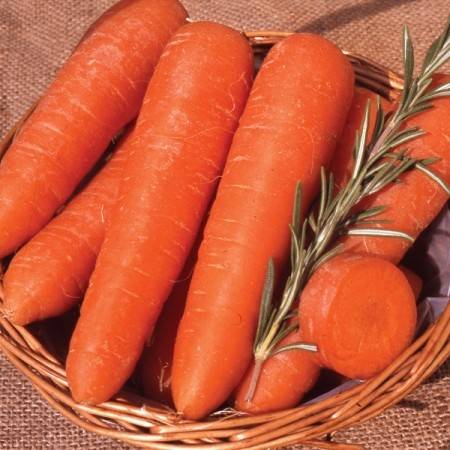

Recommended for growing in the Volga-Vyatka region. The amount of saccharides in the variety is above the average level, reaching 8.6%. With an average carotene level of 9 mg / 100 g, the Slastena variety contains up to 16.5 mg. Root crops on average 120 g. "Slastena" is recommended for long-term storage, freezing, canning. Of course, it is also used fresh.
Having a high yield (up to 90%), it is well suited not only for a private garden, but also for industrial cultivation.
Vitamin 6
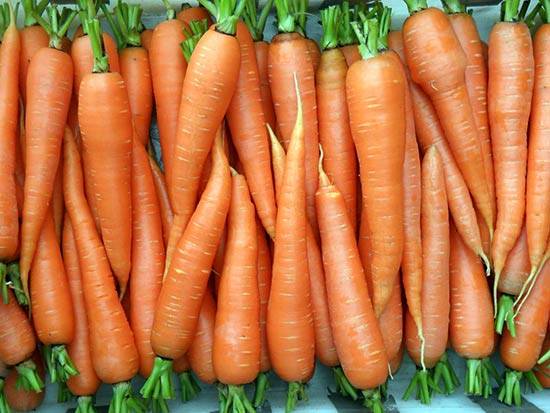

Yielding mid-ripening carrots, well suited for canning, freezing, long-term storage, making juices. Due to its very high carotene content (up to 22 mg / 100 g), it is recommended for fresh consumption and for making baby food.
Root crops are pointed, cylindrical, with an average weight of 150 g. The length of this type of carrot is 15 cm.
Best of all, this variety of carrots grows in loams and sandy loams. Seeds are usually sown in the last days of April in grooves 30 mm deep. The distance between the grooves is 0.2 m. 2 weeks after planting, the first thinning is carried out, the second - after the carrots reach a diameter of 10 mm. It is recommended to maintain a distance of 50 mm between plants. Carrots should be harvested 100 days after sowing.
The variety can be sown before winter. Winter crops are sown at temperatures below + 5 ° С to a depth of 20 mm and crops are mulched to preserve seeds from frost.
Nantes 4
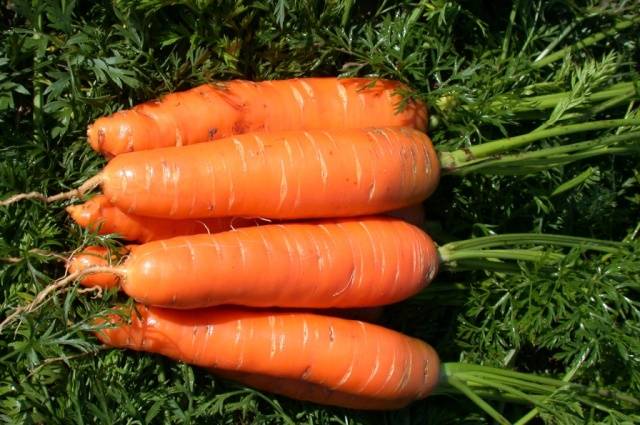

A mid-season carrot variety with a ripening period of 90 days. It is very plastic in relation to growing conditions, therefore it is recommended for all regions. Grows outdoors.
Root length 15 cm, weight 140 g. The content of saccharides is moderate, and the amount of carotene is very high: 19 mg / 100 g.
The variety is fast. During storage, it does not rot or mold. Ripe fruits protrude slightly from the ground, which is bad for the taste of the root crop. When exposed to sunlight, solanine is formed in carrots in the same way as in potatoes.
When stored for a long time, solanine penetrates deep into the root crop, giving it a bitter taste. To eliminate this problem, the protruding part of the carrots must be sprinkled with earth.
Late ripening, well-known carrot variety of French origin.Differs in excellent productivity in the region of the Middle Lane. The harvest record (995 c / ha) was recorded in the Tula region.
Like an industrial variety, Olympus has an even shape of rather large root crops. Carrots of this variety grow up to 130 g.
The variety prefers slightly acidic light soils. It is sown in April to a depth of 15 mm. Harvesting is carried out in August - September.
Reviews of summer residents
★★★★★ Anna, 25 years old, housewife, Moscow. In the summer, we grow Baby carrots in the country. The yield is average. I like the taste very much. We make juices from it. The variety has never failed - we collect the harvest annually. It was once that crooked roots grew, but this did not affect the taste and storage in any way. The only problem is that seeds are not easy to find on the market. ★★★★★ Valerina, 33 years old, gardener, Moscow region. When thinning carrots, be sure to not only pluck the tops, but also remove the root from the ground. If left there, it will rot, and this contributes to the spread of diseases. I like the processed seeds (planted by Nandrin), they are large and you can plant them one at a time, then you don't have to thin out. ★★★★★ Oleg, 69 years old, pensioner, Moscow region. I use only proven seeds, those that are in prof. packages. I like several varieties of Nandrin, Dordogne, Samson and other varieties of Nantes carrots. But I don't like Shantane carrots, because I prefer long carrots. I get a rich harvest, but there is a lot of hassle after leaving. Hide
Add your review
In the Moscow region, as in the entire Central region of Russia, it is not very difficult to grow carrots. It is only important to choose the right variety suitable for this particular area, choose the characteristics you are interested in, depending on what you want to use the resulting crop for, and, if possible, comply with the growing conditions as much as possible. In this case, you will get a full-fledged rich harvest.
0
Why are carrots bitter
Carrot fly
Very often, carrots are bitter due to damage by carrot fly larvae.
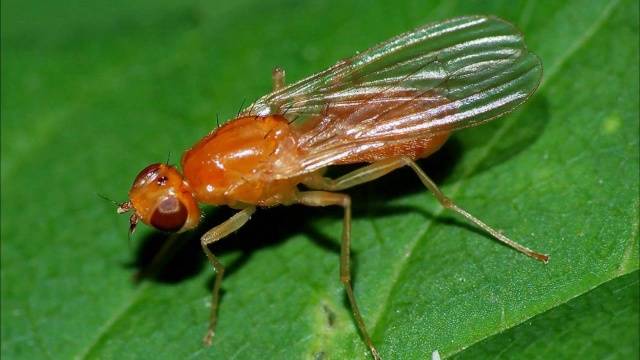

Bitterness is just a root vegetable's reaction to damage that looks like this
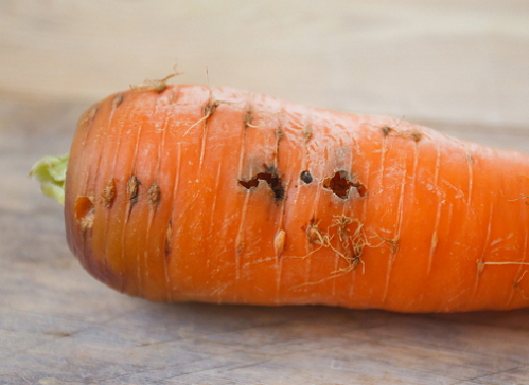

A sign of fly damage to carrots is the leaves with a red-violet color. Such plants are immediately removed.
Formed when the top of the carrot is exposed. During storage, solanine gradually penetrates into the tissues of the root crop and the carrots begin to taste bitter. There is only one way of fighting here: when growing, do not allow the tops to be exposed.
Fungal diseases
In a simple way, rot. Fungi destroy the tissues of the carrots, resulting in a bitter taste in the externally intact part of the root vegetable.
The rest of the reasons are not dangerous to health, but are laid even during the growth period:
- insufficient watering;
- too much mineral fertilizers;
- late harvesting of root crops and, as a result, their overripening;
- insufficiently fertile land.
Subject to proper farming practices, the overwhelming majority of these reasons will disappear by themselves and the carrots will be sweet, juicy and crunchy.
Another reason for bitterness: trying to grow a second generation from seeds derived from an F1 hybrid. In hybrids of the second generation, the properties of the wild ancestor of carrots begin to dominate. And the root of the wild ancestor is not only bitter, but also has a ligneous core.
It should be noted that in fact, the benefits of carrots are greatly exaggerated. The myth about the improvement of vision (myopia) as a result of eating carrots is another English hoax, along with the pharaoh dog and the Afghan hound, which has survived for decades. Only unlike the last two, the carrot bike did not pursue commercial goals, but was supposed to hide the fact of the use of radars on British Air Force planes during night flights during World War II.
The second argument against over-eating carrots is that carotene is found in many foods besides carrots. Young nettles contain 10 times more of it than carrots.An orange color is not an indication of the presence of a large amount of carotene. Melon, broccoli, and all traditional greens also contain beta-carotene. Vitamin A and carotene are stored in the liver and consumed as needed. There is no need to consume foods with carotene every day.
But it is very easy to overdose a vitamin with excessive consumption of the same carrots.
All of the above applies to carrot juice. It's even easier to overdose than just a root vegetable. No one will be pleased with non-infectious hepatitis or the birth of a child with pathology, if a pregnant woman is infatuated with carrot juice as a natural and healthy product.
Diseases
- Rhizoctonia - fungal disease. Carrot leaves turn yellow and dry out. To prevent, you should not plant carrots in places where the soil is waterlogged.
- Carrot fly... The tops of the plant become bronze. If the plant is not treated in time, the foliage may wither and the plant may die. It should be treated with special means: "Tsiper", "Arrivo", "Sharpei".
- Carrot lily... Appearance period: March. The hatched larvae cause the tops to shrink and dry out. Spraying with tobacco broth should be done.
- Aphids on carrots... Transfers from old plants. To fight, you should:
- abundant watering in the heat;
- sprinkle with ash;
- spray with herbal infusions.
Read more about the symptoms and causes of carrot diseases, as well as the methods of their treatment, in a separate article.
The best varieties of carrots with photos and descriptions
Good day everyone!
Let's talk today about the best varieties of carrots with a photo and a small description. Of course, you can't tell about everything, there are a lot of them. I will focus on well-known, time-tested varieties that do not give up their positions, even with new hybrids. All of them are divided by the ripening period into:
- Early (65 - 90 days),
- medium (100-110 days),
- late (more than 120 days).
This division does not greatly affect the quality and taste of root crops. It's just that the early ones can be used for food and processing, while the others are good for storage.
I want to note that domestic carrot varieties are much tastier and better stored than foreign ones. Foreign breeders are trying to bring varieties for sale - the main thing is that they are even and beautiful, even to the detriment of taste.
It is difficult to choose the right variety in the store. Therefore, think in advance: why you will grow carrots, and what kind of soil on your site. Here are some small guidelines for choosing:
- If you have light, loose soil, then feel free to plant long-fruited varieties.
- Short-rooted varieties are the earliest to ripen, plant in early spring.
- Round varieties grow quickly, but are not very productive.
- If you want to grow carrots for sale, choose imported varieties, this was just discussed above.
- It is better for yourself to plant domestic varieties, the taste is richer and there is more carotene.
- And they are better adapted to our climate.
Types of root vegetables
There are only two types of carrots:
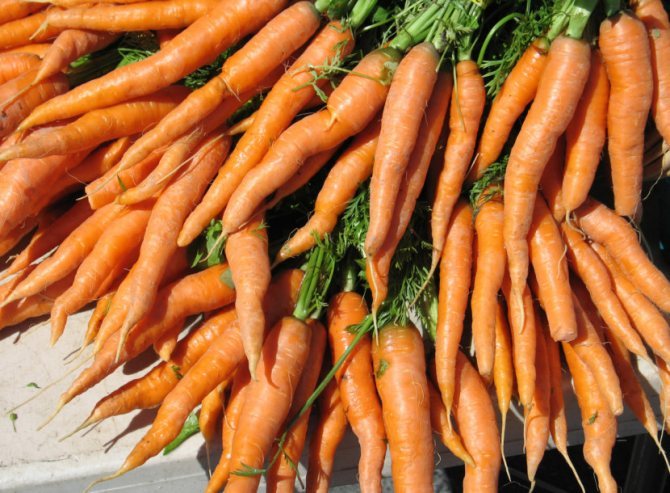

Wild. It grows naturally. Has a white or slightly yellowish tint. This fruit is not used for food.
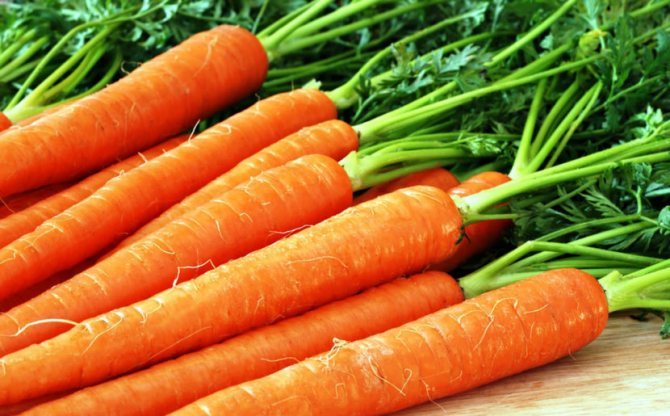

Sowing. Human grown. It is a subspecies of wild carrot. This type is subdivided into two varieties of carrots:
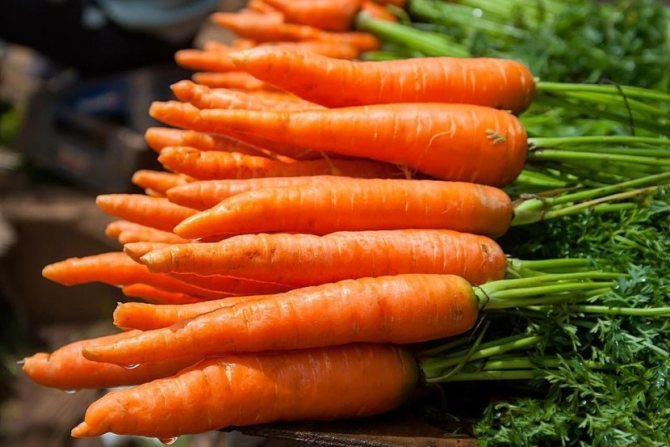

- stern;
- dining room.
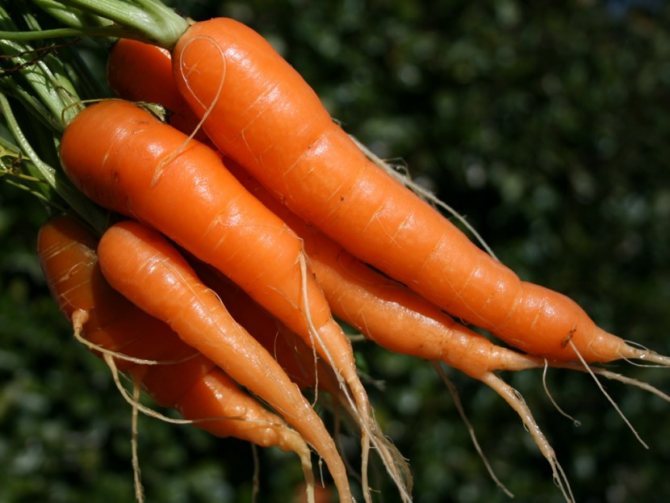

Table carrots / These varieties are grown for food consumption. The ripening period can be different:
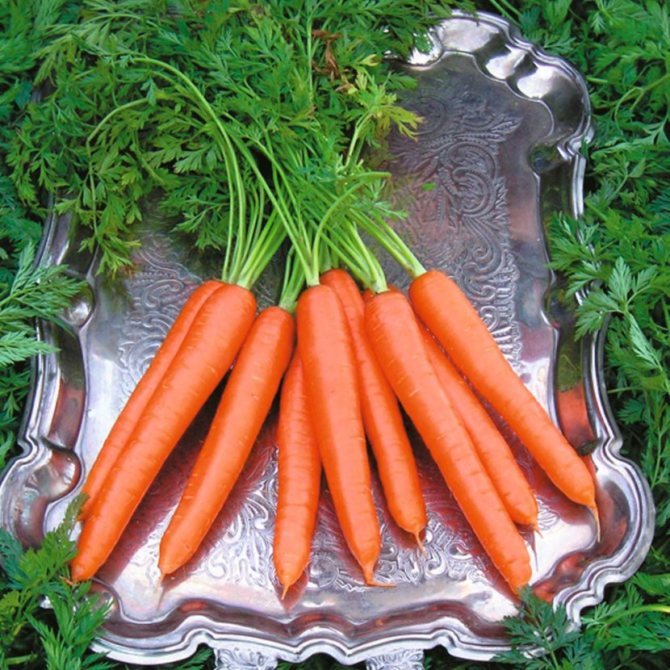

- early;
- mid-season;
- late.
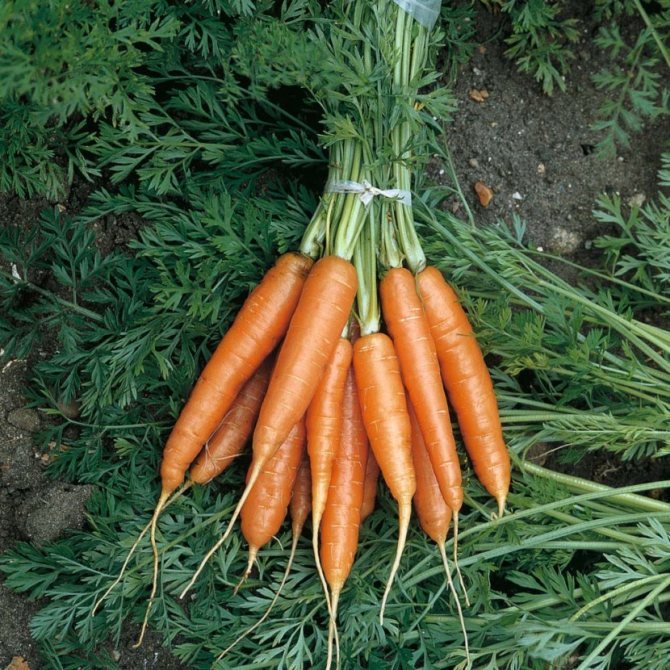

The early ones can be eaten raw or cooked. Mid-season is best eaten cooked. The late variety is the sweetest, it grows for more than 200 days.
The best varieties of carrots
Early varieties of carrots
Basically, these varieties provide early products for food and "bunch". Often these varieties have ripe fruits that are not very sweet. Productivity is small, not stored for long. But they provide an early harvest.
1. Amsterdam - fruits are bright orange with a blunt tip, small cylindrical, weighing 50-120 g.The pulp is tender, very sweet, juicy with a small center. Grown for early production, the variety is resistant to cracking, to flowering, high-yielding.
Variety "Amsterdam"
2. Carotel Paris - the earliest and most famous carrot. One of the oldest varieties. Short, almost rounded, orange fruits of excellent dessert taste - tender and sweet. Children love her very much. The yield is small. Grows well on heavy soils, loam.
Variety "Karotel Parizhskaya"
3. Parmex - fruits are almost spherical, bright orange, up to 4 cm in diameter, weighing about 50 g. The pulp is very tasty - tender, juicy. The variety is suitable for growing on heavy soils with a thin fertile layer. Good for whole fruit canning. Root crops are harvested with a diameter of 2-3 cm. A variety of the Karotel variety, it looks like it outwardly.
4. Dragon - carrots with purple skin and orange pulp. The taste is sweet, spicy. If you like unusual plants, this is the variety for you. A very healthy carrot.
Variety "Dragon"
5. Touchon - fruits are cylindrical up to 20 cm, even. The bright orange pulp is juicy and sweet. It is not stored for very long, it is better to use fresh and for processing.
Variety "Tushon"
6. Fairy - the universal purpose of carrots. Stores well in winter. Cylindrical fruits, weighing up to 170 grams.
Variety "Fairy"
7. Finkhor - a productive variety. The fruits ripen in 80 days. Carrots are large, up to 150 gr., Smooth, conical with a blunt tip. There is almost no core. The fruit has a sweet taste, rich in carotene. No need to huddle plants, as they do not grow above the ground. It is very resistant to various diseases. Unfortunately, it is not suitable for long-term storage.
Variety "Finkhor"
Mid-season varieties
They ripen in autumn, gain sweetness and juiciness by this time, the most delicious carrots grow from these varieties. Stored well.
1. Nantes 4 Is a widely grown variety in Russia. The yield is average. A very tasty variety - right to say - a delicious variety of carrots. The pulp is orange-red. Fruits are cylindrical, up to 150 gr. weight. Stored until mid-winter. Suitable for winter sowing.
Variety "Nantes 4"
2. Vitamin 6 - a widespread variety. Grows well on peat soils. Fruits are cylindrical, up to 20 cm, with orange-red pulp. Stored medium. Increased carotene content (16.4 mg per 100 g of carrots).
Variety "Vitamin 6"
3. Losinoostrovskaya 13 - The variety is well-known and quite old, it is very popular among gardeners. Fruits are cylindrical up to 18 cm long. Orange-red pulp with a high content of carotene (up to 18.5 mg per 100 g.) A valuable variety for dietary and baby food, fresh carrots are useful in salads. The variety is very productive, well kept.
4. Moscow winter A 515 - a fruitful popular variety (90 - 110 days), time-tested. Fruits are elongated with a blunt tip and a small pith. The bright orange pulp is juicy and sweet. The variety is well stored in winter - until spring, resistant to flowering. Suitable for winter sowing.
Variety "Moscow Winter A 515"
5. Incomparable - a productive variety with a rich carotene content. Conical fruits with a blunt tip. Orange flesh with a thin middle. Excellent taste, weighing up to 200 g, up to 17 cm long. The variety is resistant to flowering. Suitable for sowing before winter.
Variety "Incomparable"
6. NIIOH 336 - also a common fruitful variety. Delicious fruits up to 18 cm in size, cylindrical, tasty, orange, weighing up to 130 g. This variety contains a lot of carotene (19 mg per 100 g) and is well stored. It is not necessary to huddle it, completely immersed in the ground during growth
Variety "NIIOH 336"
7. Rote-Risen (Red giant) - a high-yielding variety. Fruits are large, up to 20 cm, conical. Red-orange, very tasty. Stored well.
Rote Riesen variety
8. Samson - mid-season (110-120 days), cylindrical fruits, orange, weighing up to 200 grams. The variety is high-yielding, the roots are tasty, leveled.The pulp is sweet, crispy, juicy - very tasty. Suitable for processing, long-term storage, useful fresh. Suitable for winter sowing.
Variety "Samson"
9. Forto - high-yielding (100-110 days). Cylindrical fruits, large, weighing up to 200 g, up to 20 cm long. The taste is good. Can be grown in all regions, keeps well and gives stable yields.
Variety "Forte"
Late-ripening carrot varieties
Slightly inferior in sweetness to mid-season varieties, but very well stored. Usually with large roots.
1. Vita Longa - long fruits, well stored until spring. When grown, they do not crack. Delicious fruits, rich in sugar and carotene. An excellent variety for juicing.
Vita Longa variety
2. Yellowstone - Fusiform fruits, aligned with a sharp tip, weighing up to 200 grams. Yellow color. The variety is very productive, good taste.
Variety "Yellowstone"
3. Queen of Autumn - a popular variety with red fruits, cylindrical in shape, up to 22 cm long, even with a sharp tip. The pulp is sweet, aromatic, tasty. The variety is resistant to flowering. Suitable for sowing before winter. Stored practically until the next harvest.
Variety "Queen of Autumn"
4. MO (Special Carrot) - high-yielding medium late variety. Fruits are red-orange, up to 20 cm, conical. The pulp is juicy and tasty. Store well. You can sow before winter. I sowed this variety last year, I liked it. Really delicious, juicy carrots, sweet. Stored well, already eaten.
Variety "MO"
5. Chantenay 2461 Is a widely grown variety. Conical fruits, short and thick. The pulp is orange, dense. Weight up to 300 g, but 500 g can grow with sufficient moisture. Average taste. Stored well until spring.
Variety "Chantenay 2461"
I told only about the best varietal carrots with photos and descriptions. I didn't mention hybrids in principle. Because I don't grow them myself and I don't recommend it to others.
Reviews of the hybrid carrot Nandrin f 1
The gardeners who planted the hybrid in their plots generally leave positive reviews about her... Many people like its beautiful appearance and rapid maturation.
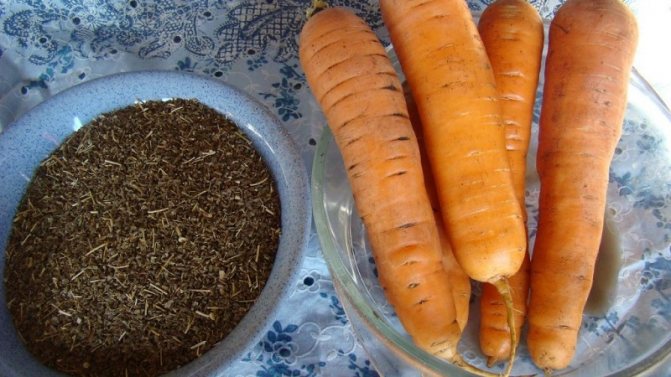

Nadezhda, Ivanovo: “I accidentally found out about Nandrin from a neighbor. Everyone admired her garden beds with a beautiful and well-groomed carrot. Now I have been planting it on my site for the third year. I like planting before winter. In the spring, after the snow melts, shoots appear. "
Vasily, Arkhangelsk: “Before, I didn't like messing with carrots. She grew up small. But when my wife planted the Nandrin hybrid, I was pleasantly surprised by its size. Now I am happy to harvest, of which there is also a lot. "
Petr, Sterlitamak: “Once I read about this hybrid on the Internet. I decided to plant it in my garden. The carrots have grown smooth and beautiful, in addition, they are delicious. But I tried to follow all the recommendations for growing, and the result was good. "
Gardeners recommend
Among all the sweetest species, gardeners give particular preference to the following:
- Early fun... The seeds of this very tasty carrot variety were obtained by breeders at the West Siberian vegetable station. Its fruits begin to ripen already 2.5-3 months after germination. The pulp of such carrots is juicy and sweet, so people are happy to use it fresh.
- Coloring is also an early ripe fruit. Great for baby and diet food. This variety has a number of advantages. Firstly, its yield can be 50 tons per 1 hectare of land. Secondly, these roots always have a uniform aesthetic appearance. Thirdly, they have a high content of carotene, which improves vision, hair and nails condition, and stabilizes the body's immune system.
- Most people know the riddle about a red maiden sitting in a dungeon. Children often give the correct answer. Is there a baby sweet carrot? Sure. They call her that: sweet baby carrots... Its consumption is recommended fresh, in mashed potatoes or juices. Carrots should be included in the children's menu of this kind. Harvested 3-3.5 months after germination.
- Later ripe, but no less tasty, is The emperor... The minimum ripening period after germination is 4 months. At the same time, the fruits are long, tasty and juicy.
- Red maiden - also a late-ripening variety, it belongs to the "Shantane" variety. These sweet root vegetables can ripen up to 4.5 months. Its advantage is the possibility of long-term storage in winter. It is not recommended to fertilize with fresh manure - the risk of getting crooked roots with several roots will increase.
Harvesting and storage of carrots Nandrin F1
The first harvest of this variety is combined with the second thinning (when the root crops reach a diameter of one centimeter). Such carrots are quite edible. The final, complete collection is carried out 105-110 days after the emergence of mass shoots.


With summer, June sowing, the fruits will reach full ripeness in late October or early November. To do this, the carrots are dug in with a garden pitchfork, pulled out by the tops and shaken off the rest of the soil. These roots are quite suitable for long-term winter storage.
Hybrid carrot variety Nandrin F1 - ideal for growing both in private summer cottages and in large farms. It is planted for summer consumption and for winter storage, this variety is high-yielding, unpretentious, resistant to diseases and pests. Nandrin F1 has an excellent appearance and good taste.
How do you grow the Nandrin F1 hybrid? Share the secrets of the cultivation of this carrot variety.
Nandrine f1 is a popular carrot hybrid developed by Dutch breeders. It is famous for its excellent taste and early ripening. Despite its relative youth, the hybrid is known among summer residents, and its seed material is in stable demand in specialized stores. Carrots attract with a high yield, beautiful and neat high quality root crops.
Sweet varieties
Previously, the sweetness of carrots was strongly influenced by climatic conditions. To date, breeders have managed to create several varieties that can be planted everywhere without losing the sweetness of the grown root crop. These varieties are:
- Amsterdam... Its roots are long and bright, and their core is thin, with prolonged storage they do not crack, the disadvantage is poor yield.
- Belgien White has an original pleasant aroma.
- Finhor - a dessert variety without a core, often used for salads or juices, its only drawback is its extreme unsuitability for storage in winter.
- Round baby. It is best diluted in small containers.
- Alyonka is a bundle early maturing sweet variety.
- Viking.
- Nantes - very smooth, beautiful and sweet carrots.
- Perfection has a juicy pulp, firm surface and the possibility of long-term storage.
- Tinga perfect as an ingredient for salads, juices and other fresh dishes, suitable for long-term storage.
Many of these fruits are large and high in carotene. However, it is not always possible to end up with sweet fruits, since carrots require proper planting and care.
Seeds Moscow winter carrots are the classic choice of many gardeners for planting. Firstly, this variety is one of the most productive. Secondly, the grown root crops are sweet, coarse, large. The variety is resistant to decay, and therefore ideal for sowing in October or November. Another distinctive feature is the possibility of long-term storage of root crops without loss of external and taste qualities.
Autumn queen... Root crops up to 30 cm long grow from the seeds of this carrot variety.The heart is small, the taste is sweet. Many housewives use such carrots not only for fresh consumption, but also for canning.
There is also an improved Nantes variety - Nanteysky... The advantage lies in the excellent yield. Compared with Nantes variety, the appearance of Nanteisky is not so beautiful, but it is less exposed to carrot flies and parasites. (Read more about carrot fly-resistant varieties here).
Read about the beneficial properties of raw and boiled carrots here.
Where do carrots grow?
Wild carrots can be found in many countries around the world. It grows both in European countries and in Asian countries. It is suitable for a mild and temperate climate.
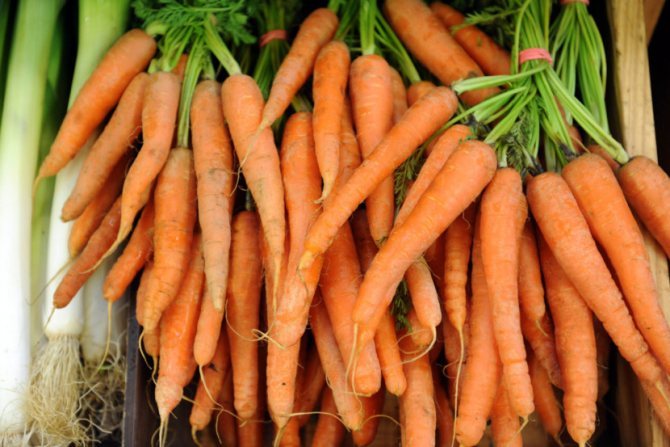

It just does not grow in areas with severely arid climatic conditions or in the Far North. As a rule, carrots grow in the forest, along the roads or on the edges.
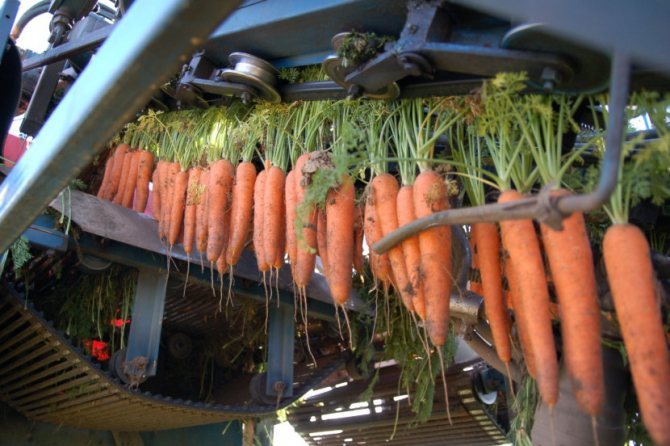

Pests and diseases
Those who were involved in the cultivation of this root crop know how bacteriosis, felt disease or brown spots that have appeared in plants can spoil the business. Nothing more joyful if carrots are attacked by carrot aphids, flies or caraway moths. However, the worst thing is when a carrot fly starts up, eating the root vegetable from the inside.
However, these troubles are not so terrible for Nandrin. As already mentioned, hybrid seeds are processed at the stage of preparation for sale. So both diseases and pests of this variety are not as scary as the rest.
As for the harmful fly, then the breeders also tried. Having found out that a high percentage of carotene does not contribute to good nutrition of the larvae, and a high sugar content even leads to their death, the scientists endowed the root crop with these properties, useful for humans, but repelling for an insect.
How to store
Hybrid carrots are stored very well without losing their qualities. In a vegetable storehouse, it lasts well until the end of spring, unlike other early-maturing varieties. It follows from this that the carrots of the Nandrin variety, due to their ability to maintain their presentation for a long time, are of interest for trade. Therefore, you can buy Nandrin carrots at any counter, be it a market or a store, almost at any time, up to the new harvest.
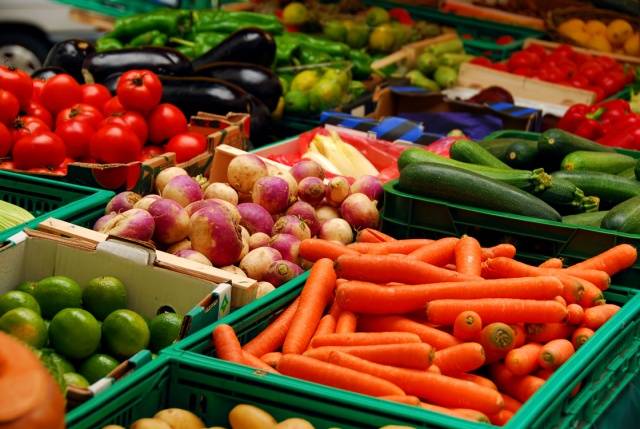

How and when to harvest
Harvesting takes place in mid to late September.
Advice! Before harvesting the "Emperor" carrots, you should thoroughly water the garden bed in advance, so as not to break the long, not too bulky, delicious fruits when digging.
After the crop has been dug up, it is imperative to air dry it for at least a few hours, then cut the tops and send it for storage or processing.
Carrots "Emperor" are fruitful by their characteristics. And these are not simple words: up to 8 kg of exceptional root crops can be harvested from one square meter. Carrots of the "Emperor" variety are stored in a cool place for up to nine months, while losses are always minimal. The root crop remains beautiful throughout the entire shelf life. Hence the conclusion: it is suitable for sale, since a carrot with such external characteristics will always attract increased attention of buyers.





